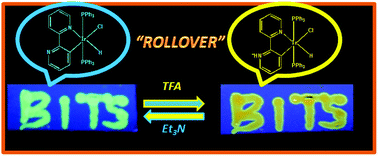“Aggregation induced phosphorescence” active “rollover” iridium(iii) complex as a multi-stimuli-responsive luminescence material†
Abstract
On reaction of 2,2′-bipyridine with iridium(III), an “aggregation induced phosphorescence (AIP)” active “rollover” complex, [Ir(PPh3)2(bipy-H)(Cl)(H)] (bipy-H = κ2-N,C-2,2′-bipyridine) or [Ir(bipy-H)], is obtained. The emission colour changes from bluish-green to yellowish-orange and vice versa after repeated protonation and deprotonation of [Ir(bipy-H)], respectively, which unequivocally supports its reversible nature. [Ir(bipy-H)] is sensitive to acids with different pKa values. Tuning of the emission properties can be achieved in the presence of acids with different pKas. This behaviour allows the complex, [Ir(bipy-H)], to function as a phosphorescent acid sensor in both solution and the solid state, as well as a chemosensor for detecting acidic and basic organic vapours. The protonated form, [Ir(bipy-H)H+], which is generated after protonation of [Ir(bipy-H)] can be used as a solvatochromic probe for oxygen containing solvents, and also shows vapochromic properties. The emission, absorption and 1H NMR spectra of [Ir(bipy-H)] under acidic and basic conditions demonstrate its reversible nature. DFT based calculations suggest that changes in the electron affinity of the pyridinyl rings are responsible for all these processes.


 Please wait while we load your content...
Please wait while we load your content...